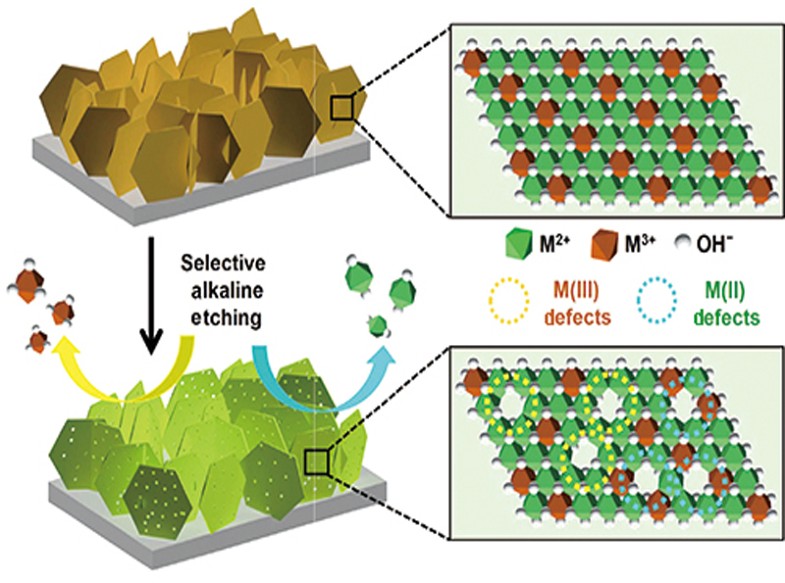Nano Research ( IF 9.9 ) Pub Date : 2018-03-20 , DOI: 10.1007/s12274-018-2033-9 Qixian Xie , Zhao Cai , Pengsong Li , Daojin Zhou , Yongmin Bi , Xuya Xiong , Enyuan Hu , Yaping Li , Yun Kuang , Xiaoming Sun
Atomic composition tuning and defect engineering are effective strategies toenhance the catalytic performance of multicomponent catalysts by improvingthe synergetic effect; however, it remains challenging to dramatically tune the active sites on multicomponent materials through simultaneous defect engineeringat the atomic scale because of the similarities of the local environment. Herein,using the oxygen evolution reaction (OER) as a probe reaction, we deliberatelyintroduced base-soluble Zn(II) or Al(III) sites into NiFe layered double hydroxides(LDHs), which are one of the best OER catalysts. Then, the Zn(II) or Al(III) siteswere selectively etched to create atomic M(II)/M(III) defects, which dramaticallyenhanced the OER activity. At a current density of 20 mA·cm−2, only 200 mV overpotential was required to generate M(II) defect-rich NiFe LDHs, which is the best NiFe-based OER catalyst reported to date. Density functional theory(DFT) calculations revealed that the creation of dangling Ni–Fe sites (i.e., unsaturated coordinated Ni–Fe sites) by defect engineering of a Ni–O–Fe site at the atomic scale efficiently lowers the Gibbs free energy of the oxygen evolutionprocess. This defect engineering strategy provides new insights into catalysts atthe atomic scale and should be beneficial for the design of a variety of catalysts.

中文翻译:

具有原子级缺陷的层状双氢氧化物,具有出色的电催化性能
原子组成的调整和缺陷工程是通过提高协同效应来提高多组分催化剂催化性能的有效策略。然而,由于局部环境的相似性,通过同时在原子尺度上进行缺陷工程来大幅调整多组分材料上的活性位点仍然具有挑战性。在本文中,我们以氧气析出反应(OER)作为探针反应,故意将碱溶性Zn(II)或Al(III)引入到NiFe层状双氢氧化物(LDHs)中,这是最好的OER催化剂之一。然后,选择性刻蚀Zn(II)或Al(III)部位以产生原子M(II)/ M(III)缺陷,从而显着增强了OER活性。在20 mA·cm -2的电流密度下,仅需200 mV的超电势即可生成富含M(II)缺陷的NiFe LDH,这是迄今为止报道的最好的基于NiFe的OER催化剂。密度泛函理论(DFT)计算表明,通过原子工程Ni-O-Fe位的缺陷工程而产生的悬空的Ni-Fe位(即,不饱和配位的Ni-Fe位)有效地降低了金属的吉布斯自由能。氧气释放过程。这种缺陷工程策略为原子级催化剂提供了新的见识,并且对于设计各种催化剂将是有益的。



























 京公网安备 11010802027423号
京公网安备 11010802027423号